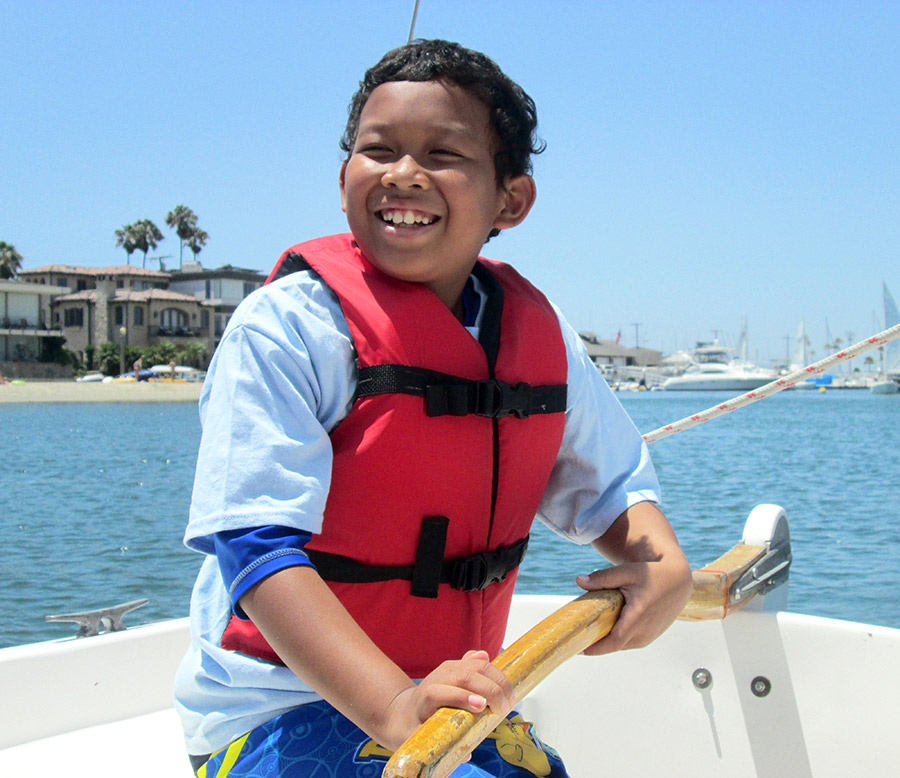
t’s a July afternoon in Long Beach and 100 people have gathered as a group of 11- and 12-year-olds take a STEAM challenge. A crowd of families, educators and elected officials have come to cheer on students as they race rowboats in Alamitos Bay.
These aren’t your everyday rowboats; these boats are handmade with only cardboard and duct tape and are designed to hold four students. The students have spent weeks creating them, practicing science, technology, engineering, art and math — a collection of subjects commonly known as STEAM. Most of the boats will sink in the harbor, but that’s not bothering the students — they’ve grown used to pushing themselves. Just earlier in the day, the students raced sailboats. With no adults. They are feeling like they can do anything.
The activity is part of the Summer STEAM Institute, a no-cost camp where the motto is perseverance. The students, all from low-income households, have spent the last three weeks doing hands-on projects and practicing 21st-century skills like risk taking and communication. The race is the culminating project of their work on these rowboats, which has included designing 3D-printed models, engineering prototypes, scaling them up to fit four people and building the final boats.
For most of the students, these summer weeks might have been spent playing video games and passing the time at home. It’s part of the summer slide: while many students from more affluent backgrounds continue learning over the break through camps or extra coursework, children from low-income families often do not. This disparity in educational access can extend throughout the year due to the differences in school funding and out-of-school opportunities.
Many schools lack STEAM resources, yet as we prioritize STEAM education, we must work to ensure every student has access to high-quality opportunities, regardless of their household income or zip code.
One way that schools can cultivate STEAM access is by engaging the broader community. Partnerships with businesses, community groups and informal STEAM organizations can create robust expanded learning programs. The Summer STEAM Institute, created by the education nonprofit Dramatic Results, models one such approach by collaborating with organizations and professionals, including chefs, filmmakers and engineers. While Dramatic Results has been providing arts integration programs for 26 years, it’s tapping the power of partnerships, knowing that by working together the whole is greater than the sum of its parts.

This collaboration, a “STEAM ecosystem,” connects students with the world outside of school, showcases careers and makes academics relevant to their everyday lives. They also get mentoring from professionals they wouldn’t usually meet. Additionally, the students and their families connect with community resources, creating ripple effects that continue long after.
One summer student, Kaela*, is a seventh-grader in Long Beach who enjoys spending time at the Growing Experience, an urban farm near her low-income housing community. Because the farm is part of this STEAM ecosystem, it was able to connect her to apply for the summer program. Kaela learned STEAM content, met mentors and is now part of the farm’s youth program and actively seeks out extracurricular opportunities. She will also participate in an extension opportunity this summer at the U.S. Sailing Center, a valuable opportunity to build relationships and expand her sense of possibility. The summer program showed significant outcomes for other students, too. According to independent evaluation, students became more interested in pursuing STEAM and their academic performance increased on almost every measure, including 9 percentage points in engineering, 5 points in design and 8 points in science.
Tip 1: Know that you don’t have to do it alone
For most school districts in California, there are organizations nearby that can serve as the backbone agency for a STEAM collaborative. These organizations can spearhead partnerships with individuals and STEAM organizations and can be the main contact for the district.
Tip 2: Take an inventory
Look for the resources that exist in your community. There may be STEAM professionals like architects and designers, or organizations like education nonprofits, cultural agencies, art museums and libraries with STEM programs that are interested in serving more students. Your district may also have a list of resources. Long Beach Unified School District, for example, has an Office of Equity, Access and College & Career Readiness that facilitates programs leveraging multiple organizations.
Tip 3: Choose the best
As you identify potential partners, keep a list that you can revisit later, and then start connecting with them. Choose to partner only with the ones who are interested and invested in your mission. They will be an extension of your efforts and will also begin to draw others in.
Tip 4: Consider your venue
Determine when and where to hold your STEAM programs. This could be during class time or out of school, such as Saturdays, summer or extension opportunities. Many schools can facilitate these programs on their own campuses by using buildings that are dormant on weekends. Jackie Robinson Academy in Long Beach USD opened its doors each Saturday morning for a recent STEAM program with Dramatic Results, which included workshops like “Coding Artificial Intelligence” with the Long Beach Public Library and “All About Filmmaking” with Dramatic Results’ Teaching Artists.
Tip 5: Consider your launch
After getting districtwide or school-wide support, consider piloting the program with a small group of students, such as a class of your gifted or high-achieving students. This gives the collaborators an opportunity to work together and start working with your school. Once the program has been tested and refined, you can expand it to your general education and special education students.
This summer, instead of serving 20 students, the program is expanding to serve 150 students through the ABC Scholars Project, a new three-year program Dramatic Results is launching thanks to a federal grant. Working with a STEAM ecosystem of nine organizations, the students will participate in the Summer STEAM Institute, a Saturday program and extension opportunities to boost their skills and civic engagement as they move into high school. There will be many more rowboats on the bay this summer, as the students make connections that will have ripple effects for years to come.
*Student name has been changed to protect privacy.
Jennifer Franka has 12 years of experience in storytelling and marketing and is the director of marketing for Dramatic Results, a nonprofit that has served 30,000 students and 400 classroom teachers. For more information on the ABC Project and its STEAM ecosystem visit dramaticresults.org. The Collaborative will also be disseminating STEAM ecosystem analysis tool later this year and a Guidebook in 2021 for replication in other communities.